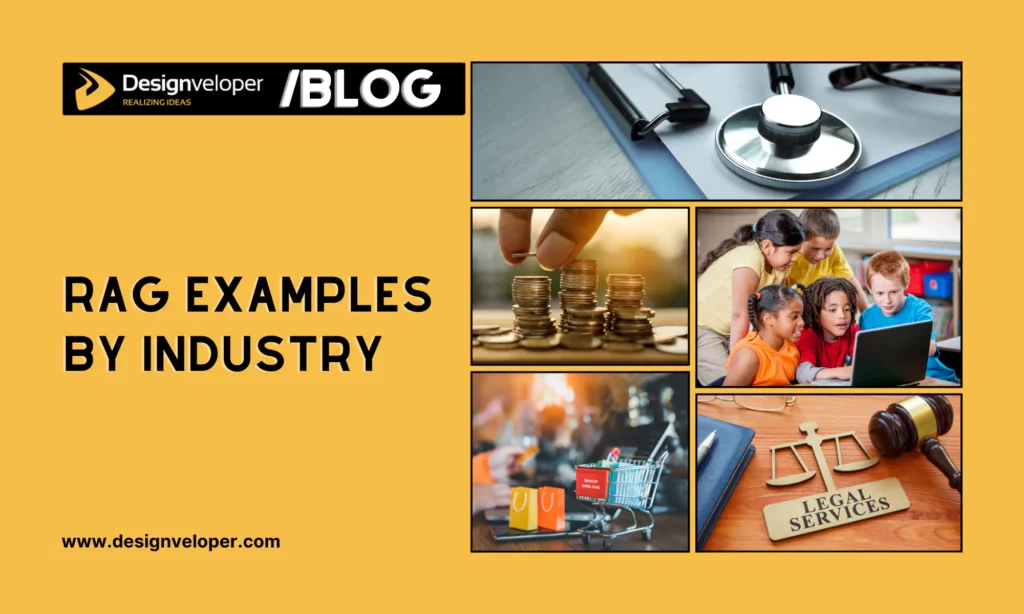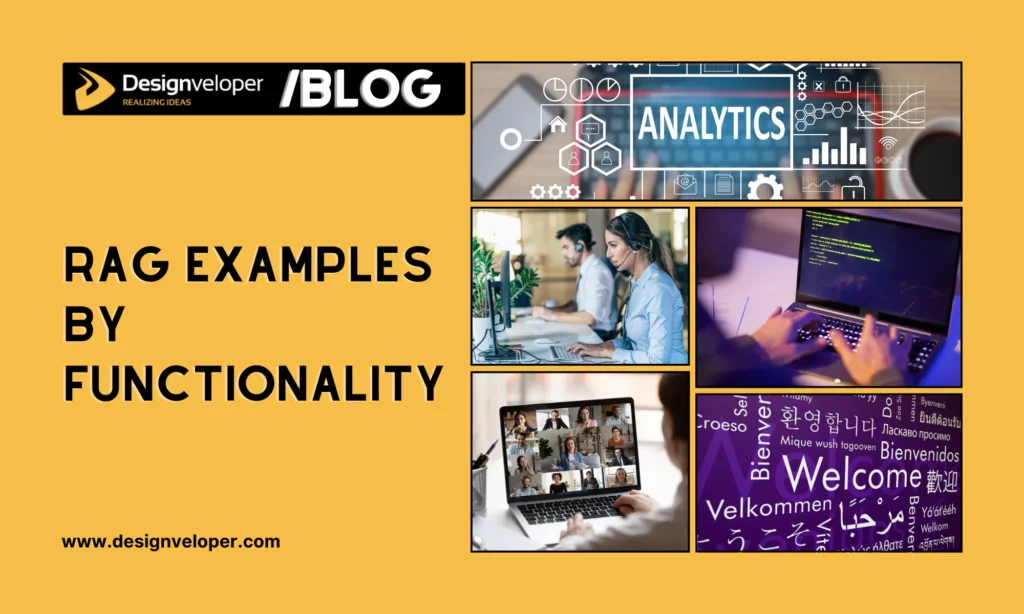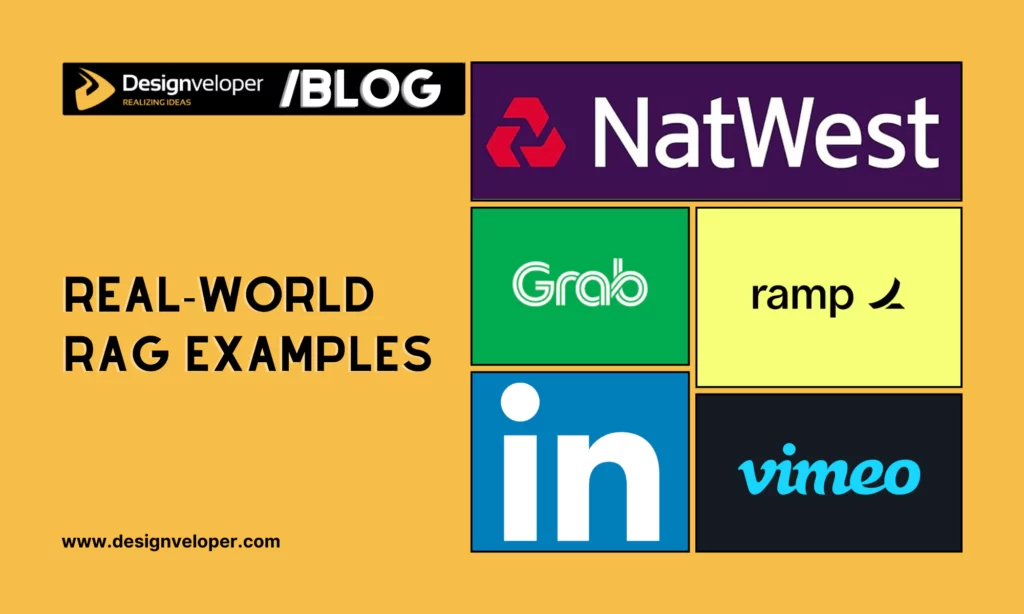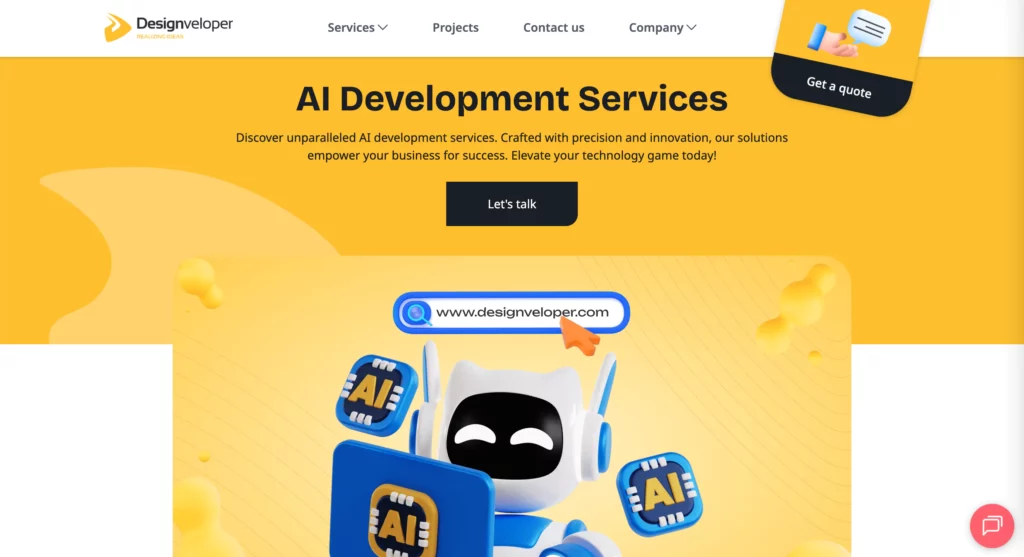The world’s knowledge is constantly changing, and LLMs need to update their knowledge constantly to complete specific tasks effectively. While fine-tuning may be a costly solution, integrating RAG proves more beneficial and economical in areas where the data always evolves. So, what are the common applications of RAG? Let’s find out in today’s article, along with real-world examples, to see how Retrieval Augmented Generation has transformed businesses:
Key Takeaways
- RAG (Retrieval-Augmented Generation) empowers LLMs to generate contextually relevant, factually correct answers by accessing and retrieving the latest, and even real-time, data from trusted sources.
- With its capabilities, RAG is widely adopted across industries, like healthcare, legal, and finance, where information accuracy and updates are crucial.
- One of the most prominent applications of RAG is in open-ended question answering. Accordingly, it’s added to conversational AI bots that handle customer service, employee support, analytical tasks, code generation, and multilingual Q&A.
- RAG is preferred when you need real-time access to the data that evolves often.
10 Retrieval Augmented Generation (RAG) Examples By Industry & Functionality
In this section, we’ll elaborate on the top 10 examples of RAG by industry and functionality.
By Industry

Healthcare
RAG plays a crucial role in intelligent applications for healthcare, where accurate and up-to-date information is paramount for medical diagnosis and consultation. The technique allows LLM-powered tools to access millions of external research papers, patient records, clinical reports, and other relevant documents. For this reason, the LLMs can retrieve the latest research findings and the patient’s personal information (e.g., demographics, preferences, and healthcare conditions) to return contextually accurate, relevant, and personalized responses.
With this capability, RAG is widely adopted in healthcare to:
- Accelerate health diagnosis and consultation based on the retrieved information from the patient’s health profiles.
- Automatically summarize medical information and findings from millions of research papers or clinical records.
- Offer explanations to particular disease symptoms or customize treatment plans depending on a patient’s preferences, goals, or healthcare conditions.
- Make the process of planning medical trials more intelligent and effective by retrieving past information to identify what worked, what didn’t, and what outcomes different patient groups experienced.
- Support drug discovery and development by fetching the most relevant insights about molecules, targets, and previous experiments. RAG also assists the LLM in summarizing biological data (e.g., gene expressions or protein interactions) and analyzing chemical compounds with relevant databases to recommend promising targets for new drugs.
Finance
Like healthcare, the BFSI industry also demands relevant, evidence-backed information to support informed decision-making. Especially in areas where raw data continuously changes (e.g., stock prices), information accuracy and updates have become more important than ever before. With RAG, financial apps powered by LLMs can avoid hallucinations and generate factually grounded answers. So, how can RAG enhance the capabilities of LLMs in finance? Let’s take a look:
- RAG supports financial analysis and forecasting by allowing for access to verified and authoritative sources (e.g., internal financial reports or regulatory documents). These sources provide recent market trends, organizational insights, economic indicators, and other valuable information to build reliable financial strategies that reflect current business realities and market conditions.
- RAG enables LLM systems to identify unusual behavior in transactions more effectively by retrieving the latest, verified information from customer profiles, transaction logs, and more. This grounds the LLM’s analysis in factual information instead of only relying on generic patterns, hence reducing false positives in fraud detection.
- RAG improves financial planning by connecting the LLM to accounting software (e.g., QuickBooks, SAP, or Xero) and pulling recent data. The LLM then uses its ability to crunch numbers for analysis or generate custom reports (e.g., profit-and-loss statements, KPI dashboards, or cash flow forecasts).
Education
Another interesting example of Retrieval-Augmented Generation is in education and research. RAG retrieves up-to-date, factual information from verified academic and educational sources (e.g., online courses, digital libraries, or research databases) to generate evidence-backed explanations for any complex topics. This will mitigate misinformation risks in academic work, turning LLMs into reliable AI tutors and research assistants.
RAG also proves helpful in course recommendations. Two researchers from Carnegie Mellon University suggested RAMO, a RAG-powered system that recommends courses on MOOC (Massive Open Online Courses) platforms like EdX or Coursera. This system uses user history and conversational prompts to improve recommendation accuracy and personalization. Based on a user’s query, RAMO searches and retrieves relevant context information from knowledge bases like Coursera and creates textual content based on the engineered prompts. The integration of RAG into the course recommendation system helps address the “cold start” problem for new learners.
E-commerce
RAG creates new opportunities for e-commerce by combining verified, up-to-date (and even real-time) data with LLM reasoning. One of its outstanding applications is creating AI chatbots with long-term memory. These conversational AI assistants retrieve the latest information from a variety of defined, domain-specific sources (e.g., product catalogues, internal policies, or customer reviews) to answer a user’s questions about product availability, refund policies, shipping status, etc.
Further, RAG-powered bots can retrieve and analyze customer data (e.g., past purchases, preferences, and browsing history) to recommend the most suitable products or find the right products faster. These bots also support teams in optimizing business operations. By connecting up-to-date sales reports, competitor data, social media trends, and other valuable information, RAG helps businesses have data-driven insights into market movements and customer demands. This helps them improve their e-commerce strategies to win over others.
Legal
RAG integrates verified, up-to-date knowledge from external sources (like case law repositories, legal precedents, or regulatory filings) to help legal professionals perform quick research while ensuring accuracy.
Additionally, it assists organizations in compliance analysis. By retrieving the most recent regulatory updates from internal compliance documents or government portals, RAG systems can explain how these updates should be applied to a specific business scenario to ensure compliance.
Another application of RAG in the legal industry is mitigating risks in due diligence by spotting potential legal gaps. In particular, when reviewing contracts, RAG cross-references terms against industry standards or compliance requirements. This helps legal professionals quickly identify risky clauses or obligations that they may overlook.
By Functionality

Customer support chatbots
One of the most commonly seen Retrieval-Augmented Generation examples is customer support chatbots. These RAG-powered chatbots go beyond generic responses. By pulling information from real-time company data, product documentation, FAQs, and more, these bots can answer open-domain questions grounded in that data. With this capability, RAG is widely adopted across applications where factual accuracy and contextual understanding are crucial. These applications often involve:
- Product recommendation: RAG chatbots access product documentation, past interactions, manuals, and FAQs to suggest the most suitable products to customers.
- Delivery support: RAG chatbots retrieve real-time information from logistics systems to answer questions about order status, shipping policies, or return processes.
- Tech support: When customers ask for technical help, RAG chatbots fetch the right information from device manuals, error logs, or troubleshooting guides to solve the given problems.
- Executive support: The bots also offer high-level, specialized assistance to executives in a company. Instead of answering generic questions, RAG chatbots pull valuable insights from company-specific sources to answer queries about company policies, market research, competitor analysis, KPIs, and more. They can also summarize meeting notes, business reports, or strategy documents. By providing data-backed responses, RAG chatbots can help executives make faster decisions.
Internal knowledge assistants
With RAG systems, employees don’t need to spend hours sifting through long policy documents or onboarding materials to find the right answers for their problems. RAG simplifies this process by extracting only the most relevant documents and returning contextually accurate answers with the links to those documents. For example, if an employee asks, “What is the company’s data retention policy?” RAG will retrieve the exact policy clause.
Further, RAG speeds up the onboarding process. When new employees ask about workflows, internal tools, HR benefits, and more, RAG assistants will fetch the latest documents or training modules in a second. This minimizes reliance on HR or IT teams and accelerates knowledge transfer.
Analytical tools
Another common Retrieval-Augmented Generation example is in analytical tasks. These tasks often require the latest numbers, reports, or documents. With the RAG technique, the LLM can pull in fresh and domain-specific data instead of depending only on static datasets. For example, when a sales analyst asks, “How was Q3 performance compared to Q1?” RAG retrieves up-to-date sales reports and then analyzes trends. This allows the model to perform context-aware analysis and offer factually accurate insights. Also, this saves data analysts hours of manually reading through thousands of documents.
With this ability, RAG-powered analytical tools are widely adopted across industries. For example, in sales and marketing, managers can pull in real-time CRM and ERP data to get insights into the performance of their sales reps or customer feedback about the new product lines. In finance, these tools help financial analysts to fetch the filings and summarize risk factors. Or in healthcare, these RAG tools reference actual clinical studies retrieved from medical databases to support the analysis of treatment outcomes.
By combining grounded AI reasoning and data retrieval, RAG-powered analytical tools can make more accurate, contextual, and scalable insights grounded in up-to-date and relevant data.
Code generation and technical support
RAG helps LLM systems generate or improve code by extracting relevant external knowledge from trusted sources like GitHub, Stack Overflow, or company repos. Here’s how it works:
- Without RAG, the LLM may hallucinate functions or APIs that naturally don’t exist. But with RAG, the LLM will generate code that matches real-world libraries and frameworks by pulling relevant documentation, code snippets, or API references.
- RAG helps the generative model to explain what a piece of code is used for by retrieving similar documented examples or contextual explanations.
- It also improves code auto-completion by extracting simpler code patterns from large repositories instead of guessing.
- When code has errors, RAG connects bug reports, correct implementations, and patches to the LLM. This allows the system to suggest the contextually correct debugging methods.
- RAG is also widely used in testing and security. It lets the generative model access known vulnerabilities, test cases, or attack patterns from external databases (e.g., internal security logs or CVE). With the retrieved information fed in, the model can generate suitable tests and perform security and functional testing effectively.
Translation and multilingual Q&A
Large language models like ChatGPT or Google Gemini already perform well in translation and multilingual Q&A. However, using RAG in these systems can improve their capabilities. Languages change every day, with new words created and some old words fading away. Because LLMs are trained on static datasets, they may depend on unsuitable or outdated terms to handle cross-language or translation queries. So, integrating RAG helps the models instantly update changes in language and produce more accurate responses.
Another challenge of LLMs that need RAG to resolve comes from domain-specific needs. Many users want multilingual answers or translations related to specialized fields, such as technology, law, or finance. With RAG, the generative models can access the most recent knowledge in these domains, ensuring context-aware translations and multilingual answers.
Real-World RAG Implementations

RAG is estimated to reach nearly $2 billion in 2025 in its global revenue. With its transformative benefits across various industries for knowledge-intensive tasks (e.g., question answering or summarization), it’s no wonder that RAG is that important. Realizing the huge potential of RAG, many companies have integrated this technique into their existing software and tools for different tasks. Let’s see some real-world Retrieval-Augmented Generation examples as follows to see how RAG has benefited these companies:
NatWest – Financial Support
NatWest is a prominent British banking and financial services group. In late 2024, the banking institution continued to cooperate with IBM to move from its classic Cora to Cora Plus, which uses RAG technology.
While its predecessor, Cora, offered a link to a general page so that customers could self-research therein, Cora+ can understand the context and nuances of each query. It retrieves NatWest’s curated knowledge base to generate personalized and precise responses. Whether it’s about cancelling a transaction, changing an address, or requesting a new card, Cora+ can proactively handle within the chat with a surprising 99% accuracy. This dramatically mitigates handoffs to human agents.
Grab – Analytical Tasks
Grab’s Integrity Analytics team built an RAG-powered LLM solution to automate and streamline repetitive analytical tasks, such as creating and summarizing regular reports or performing fraud investigations.
The solution integrates various tools, typically Data-Arks and SpellVault. SpellVault is an internal LLM tool where Grab stores, shares, and fine-tunes LLM prompts. It has no/low-code RAG capabilities that allow everyone to create LLM applications. Meanwhile, Data-Arks is an in-house Python API platform containing various APIs. With RAG, SpellVault can call relevant Data-Arks APIs to extract data from various integrated sources and answer specific questions.
With these core components, Grab developed a Report Summarizer to summarize key insights for reports, saving around 3-4 hours to generate each report. Further, the team built the A* bot to investigate fraud. After receiving a user’s query, SpellVault will use RAG to choose the most relevant Data-Arks APIs, execute them, and generate answers through Slack.
Ramp – Industry Classification
Ramp is a financial technology company based in Manhattan. The company aims to exactly understand the industries of its customers to ensure better compliance, monitor portfolios, target sales, and more. However, industry classification is challenging for some reasons, like fuzzy industry boundaries or very little publicly available data. Not to mention that Ramp’s old industry classification system was non-standard and built from third-party data, customer self-reporting, and sales-entered data.
To address this problem, Ramp migrated all its industry classifications into NAICS codes and built a new RAG system. This online RAG solution can compare text embeddings of a query and Ramp’s knowledge base to calculate similarity scores and generate recommendations that are fed into an LLM to make a final prediction. The knowledge base embeddings are stored in ClickHouse to quickly retrieve the most relevant info. Ramp’s engineering team also uses Kafka to store intermediate outputs (e.g., similarity scores or LLM Query 1). This allows the team to see where things might go wrong and enhance the prompts over time.
Vimeo – Q&A Video
Vimeo developed a Q&A chatbot to answer questions about the content of videos. Its system uses the automatically generated closed captions displayed in videos (known as video transcripts) as the source. These transcripts are broken down into small, meaningful chunks, which are vectorized and stored in a vector database for efficient searches and retrieval.
When a user asks something about the video, the RAG-based system also embeds the query and extracts the most relevant information. This info is then fed into the LLM to create a natural language response. Further, the video Q&A system displays relevant reference moments in videos to support the response.
Vimeo’s chatbot also uses RAG to generate new related questions. By embedding the chat answer to a vector representation, the chatbot continues to search for content similar to the answer in a vector database. This content may contain relevant topics that the original retrieval hasn’t covered, hence offering a wider context to generate follow-up questions. These questions:
- must relate to the same general topic as the original question;
- aren’t answered in the chat response;
- can be answered with the extracted information.
LinkedIn – Customer Support
In mid-2024, LinkedIn introduced an LLM-based customer service Q&A system that integrates a knowledge graph (KG) and retrieval-augmented generation (RAG). This integration boosts retrieval accuracy by preserving the original structure of customer service tickets, while improving the quality of answers by keeping related information complete and connected. LinkedIn’s novel approach reduced the average per-issue resolution time by 28.6% within six months after deployment.
Here’s how this new system works:
- Phase 1 – KG construction: The system builds a comprehensive knowledge graph from historical customer service tickets (e.g., past issues, complaints, or resolutions). Each ticket is represented in a tree format with sub-components (title, description, etc.) and interlinked based on relational context. Then, the embedding model will convert every part of each ticket (”node”) into a vector for easy semantic searches.
- Phase 2 – FAQ: When a customer asks something, the system analyzes the query to identify named entities (e.g., summary, priority, root cause) and intents. The system then navigates the KG and retrieves a sub-graph (a set of the most relevant information). That extracted sub-graph is passed into the LLM to generate a coherent, contextually coherent answer.
FAQ:
In what scenario would a RAG model be more suitable than a traditional language model like GPT?
RAG systems are better than traditional language models when your specific tasks require factually accurate, contextually relevant, and personalized outputs. Traditional models use static knowledge bases and lack the capabilities to actively update their core knowledge. Therefore, RAG is essential to bridge the knowledge gap in these models.
Is Bert a RAG model?
No, BERT is an encoder-only transformer. It understands and processes input, but doesn’t have capabilities to generate new context like decoder-only transformers (e.g., Google Gemini). For this reason, you can add BERT to the RAG pipeline to create the embeddings for queries and documents.
Is RAG better than fine-tuning?
No. RAG and fine-tuning are two different approaches to enhancing the capabilities of large language models. Which one to choose depends heavily on your specific task and context. Fine-tuning refers to adapting the generative mode to a domain-specific database. It’s a good option when your AI handles tasks for a certain specialized field (e.g., medicine) and knowledge doesn’t change often. Meanwhile, RAG is a better option if you need real-time access to ever-evolving knowledge.
Deploying RAG Effectively With Designveloper

Designveloper is one of the leading software development and IT consulting companies in Vietnam. We master 50+ modern technologies to deploy high-quality, scalable AI solutions that connect to your internal data sources securely. With deep technical skills in emerging tools like LangChain, we don’t just develop AI bots to answer generic questions. But our bots can flexibly generate contextual responses grounded in your up-to-date, verified data. Using RAG, we integrate different features to power our conversational bots, from memory for multi-turn conversations to API connectivity for real-time data retrieval.
Our AI solutions help clients attract target customers and receive positive feedback. For example, we developed a product catalog-based advisory chatbot. Integrated into the client’s website in the form of bubble chat, the conversational bot can offer specific product information based on a user’s query, suggest the right products for the user’s needs, and auto-send confirmation emails.
With our proven Agile approaches, dedication to excellence, and more than 200 successful projects, we commit to delivering your project on time and within budget. Contact us now and receive a detailed consultation on your RAG project.


